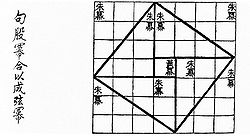Zhoubi Suanjing

The Zhou Bi Suan Jing, or Chou Pei Suan Ching, (周髀算經) is one of the oldest Chinese mathematical texts. The title literally means The Arithmetical Classic of the Gnomon and the Circular Paths of Heaven.
This book dates from the period of the Zhou Dynasty (1046 BCE—256 BCE), yet its compilation and addition of materials continued into the Han Dynasty (202 BCE – 220 CE). It is an anonymous collection of 246 problems encountered by the Duke of Zhou and his astronomer and mathematician, Shang Gao. Each question has stated their numerical answer and corresponding arithmetic algorithm. This book contains one of the first recorded proofs of the Pythagorean Theorem.
Commentators such as Liu Hui (263 CE), Zu Geng (early sixth century), Li Chunfeng (602–670 CE) and Yang Hui (1270 CE) have expanded on this text.
References
- Boyer, Carl B., A History of Mathematics, John Wiley & Sons, Inc., 2nd edition, (1991). ISBN 0-471-54397-7.
External links
- Full text of the Zhou Bi Suan Jing, including diagrams - Chinese Text Project.
- Full text of the Zhou Bi Suan Jing, at Project Gutenberg
- Christopher Cullen. Astronomy and Mathematics in Ancient China: The 'Zhou Bi Suan Jing', Cambridge University Press, 2007. ISBN 0521035376

